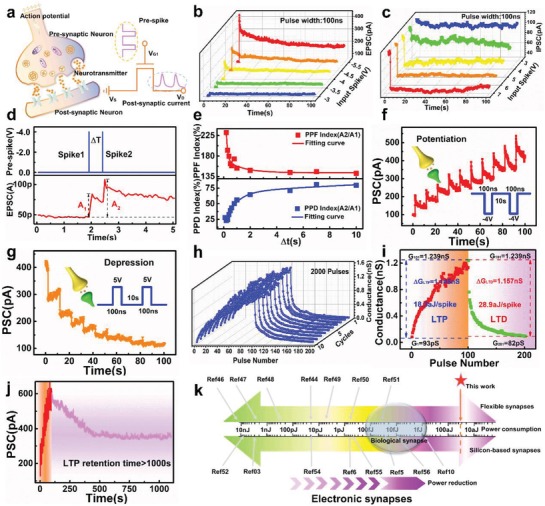Figure 3.

Electrical modulation of ultralow power MoS2‐based artificial synapse. a) Schematic of signal transmission from pre‐synapse to post‐synapse in biological synapse and emulation in MoS2 device by electrical pulse. b) EPSC triggered by presynaptic pulse with different amplitudes (−3, −3.5, −4, −4.5, and −5 V). The pulse width was fixed at 100 ns. c) IPSC inhibited by different positive pulse (amplitudes: 3, 4, 5, 6, and 7 V) with the same pulse width of 100 ns. d) EPSC generated by a pair of pre‐spikes (−4 V, 100 ns) with an interval of 500 ms. e) PPF and PPD index (A2/A1 × 100%) as a function of interval time between two continuous pulses, fitted by exponential curves. f) Long‐term potentiation stimulated by a series of pre‐spikes (pulse amplitude = −4 V, pulse width = 100 ns, pulse interval = 10 s). g) Long‐term depression simulation: a series of pre‐spikes (5 V, 100 ns) at 10 s intervals. Inset presents the waveform used for simulation. h) Endurance of potentiation‐depression with 2000 consecutive spikes. i) Ultralow power during LTP and LTD simulation in MoS2‐based synapse. ΔG LTP is 1.146 nS with 100 negative pulses (−4 V, 100 ns) in LTP, where the average power is 18.3 aJ per spike. j) Long‐term retention behavior after applying 10 pulses (−4 V, 100 ns) for over 1000 s. k) Comparison of power consumption in biological and various electronic synapses. The level of attojoule power consumption is lower than ≈10 fJ of bio‐synapse.
